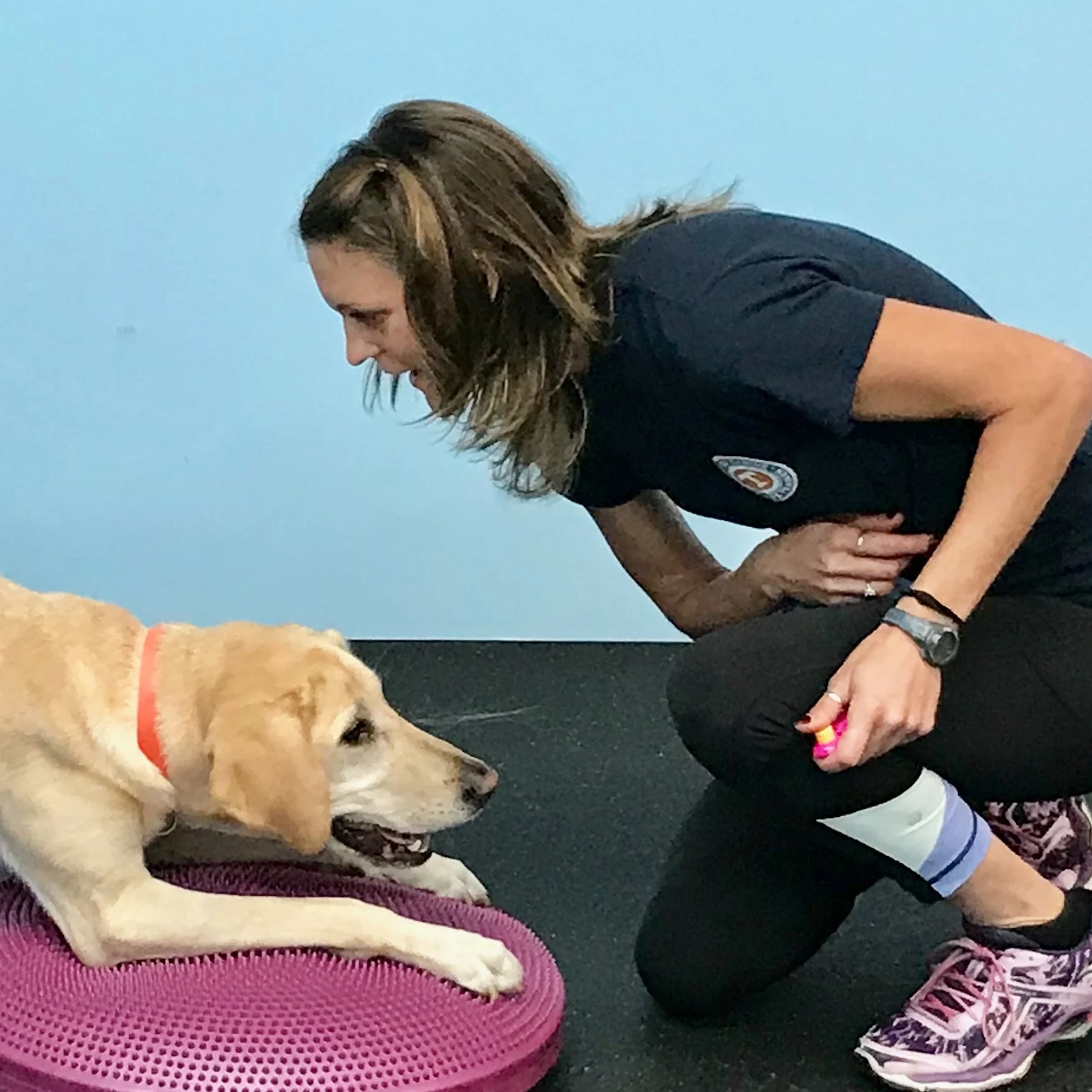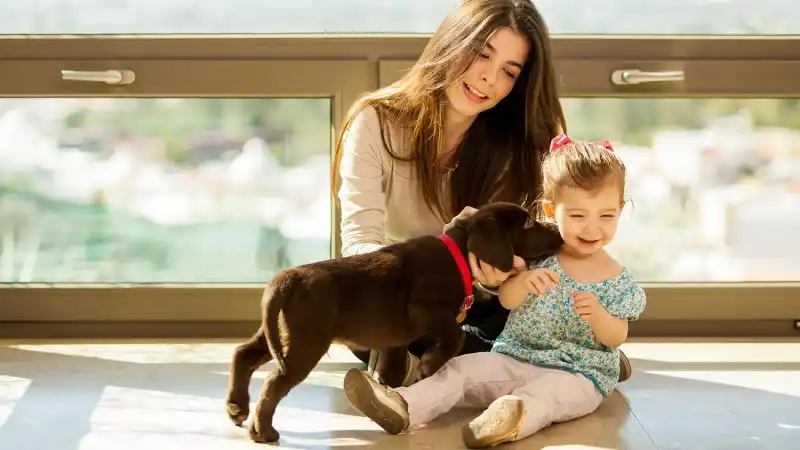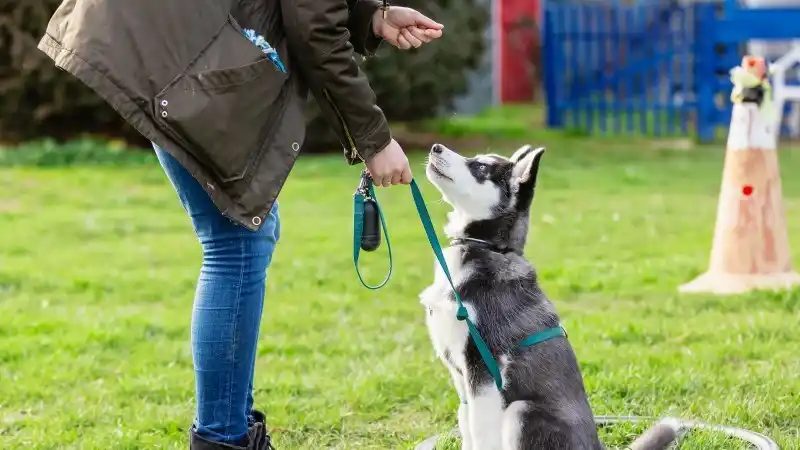Canine Fitness with Paw Pods
Learn about fitness paw pods and how to train your dog with them, substitutions you could use, and how to progress to more advanced configurations!

Many dog owners love the small size and portability of Paw Pods. Often a favorite for hotel room training and road trips, Paw Pods are great for a variety of challenging exercises and can mentally stimulate your dog. Some owners even keep a set of four pods in their car for a quick grab-and-go training session at a local park.
Read on to learn about how to train with this nifty piece of equipment, what substitutions you can use, and how to progress to more advanced configurations!
Train Front Limb Targeting Using Pods
Before you can ask your dog to front limb target, or to place their front paws on two of the pods on cue, you must be able to do front limb targeting (“toes”) on more stable and larger objects. You can use the luring method discussed in a previous blog or read on to learn about teaching it using offered behavior.
Kneel in front of a phone book or other low platform, such as a foam pad. Start by tossing a cookie across the room in front of you; and your dog will go eat the treat and come trotting back to you, since you are at their height. When they return to check in with you, they will accidentally place their front feet on the object. There is not enough space between the object and you for the dog to place their front feet (and neck and head), so they will be forced to stop with their front paws on the object.
In addition, your treats are about the dog's nose-level, so your dog will curiously return to you and remain standing with their forelimbs on the object. Say “yes” and toss a treat behind the mat to reset your dog for the next repetition. Remember, the “yes” denotes when the dog earned the treat!
Over time, you can gradually switch to standing instead of kneeling. Eventually, toss the treat at different angles so your dog returns to the object from different directions. You can also add a verbal cue (“toes”) before the dog reaches the object.
You’ll continue to generalize to more unstable and/or smaller equipment. If you started with a phone book, progress to a foam balance pad, balance disc, and other unstable objects. Sometimes, instead of saying your marker word “yes” for front paws on the object and then tossing the treat, say “yes” and treat the dog on the object for duration. Continue to give enough treats so that your dog learns to stay on the object for longer periods, before giving the release word “ok" to indicate that your dog may dismount.
After you have mastered “toes,” on other objects, put all four Paw Pods in a clump, positioned into a square made of four circles. Cue your dog for “toes.” Say “yes” and treat for front feet on any of the Paw Pods. Over time, your dog will learn to balance a paw on an individual paw pod center. Reduce to three pods and then two pods as your dog masters the technique.
Be sure to tell them “yes” when they do the correct skill and give them a treat. Let them know when the exercise is over by saying “ok” and encouraging them to gently step off the pods.
Train Hindlimb Targeting Using Pods
Similar to the front limb training progressions mentioned above, you can also teach hindlimb targeting (“feet”) on objects using the luring method or the offered behavior method.
When doing offered behavior for hindlimbs, you may want to start with a folded towel or mat as your object, since your dog will not want to pause with their hindlimbs on a phone book or foam pad. Over time, you will use a smaller and higher object than the initial towel or doormat. Be sure to give your dog enough room for their forelimbs and front half of their body between you and the folded towel.
Train All Four Paws
After your dog is proficient in fore and hindlimb targeting to two pods, line them up in a configuration that will allow them to be in a neutral, normal standing position with all four paws individually on a pod. Before you progress to four paws on all the pods, your dog should find placing their paws on the pods highly rewarding and valuable.
Ask your dog to do front limb targeting (“toes”) and reward your dog with a treat. Then, ask them to do hindlimb targeting (“feet”). Strive for your dog to maintain their forelimbs on the front two pods. Treat them for getting all four paws on the pods! Repeat a few times.
Over time, change your cueing from using both “toes” and “feet” to using just a single cue, such as “stack” or “hop it up.” Your dog should receive enough treats that they hold the position for 2-10 seconds until you release them with your “ok.”
Alternative Configurations and Drills
After you can do all four paws on the pods, you can expand your choreography!
Try these skills:
Shake each paw individuallywhile keeping the other three paws on the pods. Return the “shake” paw to the pod and shake a different paw.
Add a bit of distance, which will cause a slight straddle, between the front and rear pod configuration. Perhaps move them one centimeter or one inch further apart sideways. Thus, your dog’s forelimbs and hindlimbs will need to straddle slightly to get on the pods. If this is too difficult, your dog will tell you by stepping off the pods. Respond by putting the pods closer together.
Use just two pods for all four limbs! The forelimbs will be on one pod and the hindlimbs will share the back pod. Your dog will be in a neutral, normal spine posture and their limbs will adduct (move toward their centerline).
Stack the Paw Pods on other equipment, such as a rocker board or step bench, before asking your dog to put two or four paws on the pods.
Mix and match equipment. For example, use two Paw Pods for the forelimbs and a small inflatable, such as a disc or a ramp, for the hindlimbs. You can then do other skills such as tuck sits, stands, rock back sits, and so on!
Substitutions
Be creative! If you do not have Paw Pods, you could use tuna cans, cat food cans, or small foam squares from packing materials. If your dog needs more traction, wrap your substitutes in athletic or medical tape.
Join a Class!
To find classes near you or to learn more about how to safely use your equipment, find a Certified Canine Fitness Trainer (CCFT). A CCFT can guide you in program design and in the proper number of repetitions and sets per exercise.
Besides being a blast, doing canine fitness helps keep your dog at anappropriate weightand physically fit. Doing fitness exercises with proper form can help prevent injuries and ensure your pup recuperates faster when they do get injured. Just as humans check with their doctors before engaging in new fitness routines, dog owners should check with their veterinarians before proceeding. If you ever see any changes in your dog’s health or notice any discomfort, stop the activity and contact your veterinarian.
Take some of the stress out of unexpected emergencies with Accident & Illness Coverage from AKC Pet Insurance (underwritten by Independence American Insurance Company). Our pet insurance plans are designed to be there when you need them, allowing you to focus more on the health of your pet and less on costly veterinary bills. Click here for a quote today!

Jasey Day holds the Certified Canine Fitness Trainer (CCFT) credential through the University of Tennessee. She is a member of the Bobbie Lyons K9FITteam - a team of compassionate canine fitness instructors who actively teach others and continually expand their own knowledge. Since 2004, Jasey has taught a variety of workshops and classes on the following: Puppy, Canine Good Citizen/Family Pet, Advanced Family Pet, Canine Fitness, Canine Swimming, Rally, and Agility. In addition, Jasey has earned over 60 titles in Dock Diving, Agility, Rally, CGC and Trick Dog. Jasey has worked full time for the American Kennel Club since 2007 and teaches at Care First Animal Hospital in Raleigh, NC. Jasey’s Labrador Retrievers spend their free time hiking, training, and snuggling with Jasey.
READ MORE ARTICLES

